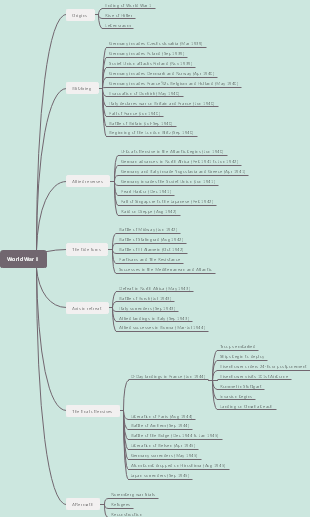MindMap Gallery Modern India
- 436
- 1
Modern India
This is a mind map that contains information about modern India and the caste system.
Edited at 2020-10-12 05:51:49- Recommended to you
- Outline
Modern India
The Beginning of the Caste System
The Aryan nomadic warriorscame into northern India
They divided the indian peopleinto separate castes
the castes that they made wereunchangeable
the caste system reflects theAryan way of thinking: Firstcame the priests, then thewarriors and then themerchants
The Aryans put themselves on the top of theCaste System, and the people that lived thereon the bottom
How the caste system prospered
each caste was expected to fulfill their dutyin order to have the other castes prosper aswell.
It was held by law for thesubcontinent and lasted twoor three thousand years
It was supported by marriage,royal support, caste rules, andpreferential treatment
They thought that a Hierarchy was natural, andthat they needed to define purity and impurity.
Both Buddhism and Jainism tried toreformat the Caste System but bothreligions failed
The Hindus in the Caste System
Hindu rulers were a giant force, and if you werewilling, you would be inducted into the castesystem
The only time that the Hindu military was not atthe highest power was when the british and theturks came in
The 4 Varnas were adoptedby the Hindus
They made it so many of lifes choiceswere made for you like jobs andmarriages
NonHindus in the Caste System
Christians
Christian missionaries have been known toassist Indian Dalits with resources andeducation
3 percent of India's population is Christian,they make up 50 percent of the Dalitpopulation
Christian leaders in India provide a senseof protection for the Dalits, many on theNCM
Upperclass Christians
The upper class christiansdiscriminate against lower classchristians
Dalit christians do not go to the same churchas them, or they sit in a different section ofpews
they do not grant Dalits witheducation from the nuns or priests
Many Dalits have spoken out againstthe discrimination of the CatholicChurch
Foreigners
All the people that are not hindu or notpart of the 4 Varnas are considered"Untouchable"
Anyone that lives in Indiaand comes from a differentancestry are part of aRajput community
Jews
The Western Jews ( alsocalled the Bene Israel)had a low status inIndia
Orthodox Hindus consideredJews Untouchables because theywere nonHindu
Jews in Southern India,(Cochini Jews) had a higherclass in India
There are three main groups of Jews inIndia: The Baghdadis, the Bene Israelsand Cochinis.
Muslims
They were treated asUntouchables, but had a strongmilitary force
They tried to force theirreligion on the Indians.
They developed a two tierhierarchy: Ajlaf Jat, SharifJat
Caste System in Modern India
History of the transition from acaste system to modern day
Industrialization firstencouraged mobilitybetween castes
this encouraged urbanization,more people moved to the cities
even in cities today that have low and high classpeople, low class people are not allowed to beburied there because there ghost will pollute thearea
The British government tried to get more rightsmore people in the lower class, but could notbreak the system
On November 29, 1949, the Indianconstitution was passed that finally broke thecaste system
How the old Caste System stillaffects people today
The Untouchables in communities today
this includes not getting thesame jobs as others, limitededucation, and having lessresources
In most low class areas, onehousehold of women may only ownone dress
villagers that go into the city to look for jobsare usually encountered with people thatdesire to hurt them like mofia gangs
A highly educated brahmin doctor will stillwrap a Dalit with cloth before touchinghim/her
There has been another termgiven to defineUntouchables,Harijan
There are two kinds of Indians,the rich and the poor
India's growing economy has madea clear line between the twogroups.
Today, people are not limited by who theirfamily's are, they can work their way up to thejob they desire.
90 percent of poor Indians areDalits and 95 percent ofilliterate Indians are Dalits
those once artificial barriers between castes stillhas an affect on people today because the castesystem played a huge role in society
Occupations in the Caste System
General Information
Within each Varna there is "Jet" inwhich each family passes down thatspecific occupation to their futuregenerations.
Each Varna needs to fulfill their duty, theHindus believe it is what makes theuniverse function
The 4 Varnas: Created bythe Hindus
Vaishyas
they are landlords and businessmen of thesociety
They are motivated by material objects
The Brahmins
They are priests andeducated people of thesociety
Like the Kashatria and the Vaisia,they are considered "twice bornpeople".
They are motivated by knowledge
Kshatriyas
they are the ruler and thearistocrats in the society
They are motivated by power
Shudras
They are the peasants andworking members of society.
Even though they are the lowest of the4 Varnas, they work in cleanenvironments.
They did not have the same social andeconomic rights as the other 3 Varnas,just as the Untouchables
They are "unmotivated" people
Outside of the 4 Varnas
The Untoucahbles
They are not have contact with the other4 Varnas, they do not get the same jobopportunities
They were people that worked in uncleanenvironments, they were seen as polluting andunclean people
Panchamas
these are outcasts in India, theychose not to be part of the castesystem
they have caused serious crimes against thecaste regulations that led to them being kickedout of Hindu society.
The Sannyasins
they are not part of the castesystem on purpose.
They have decided to focus onselfrealization
some have become swamis who choose tonot care about any orders of the caste system









